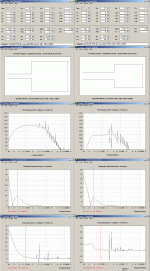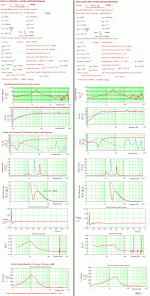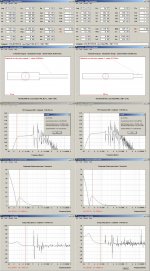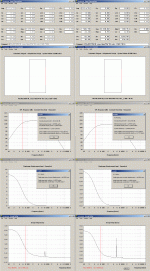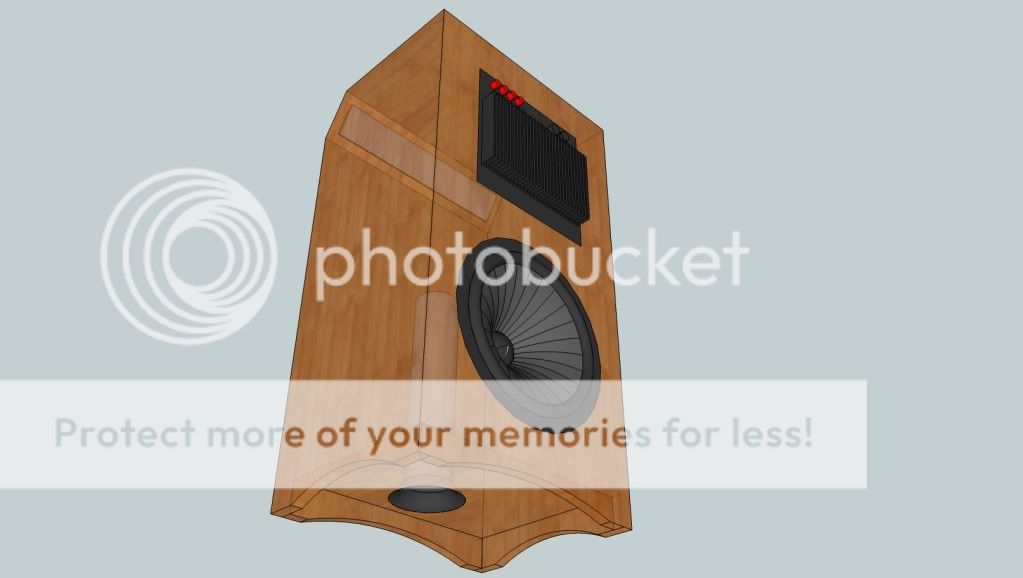An externally hosted image should be here but it was not working when we last tested it.
Vifa NE315W-04 12" Neodymium Woofer
link to partsexpress product page....
Vifa NE315W-04 12" Neodymium Woofer
low volume, low demand, highly accurate low bass for 100 percent music (no HT).
I ran it through WinISD. With Qtc of .71, it needs a 1.83 Cu ft. box. F3 at around 45 Hz. It is not very efficient 4 ohm driver at 88.6db 2.83v/1m (85.6db/1w). 10db down at around 25Hz. Seems to be good for what you want. Larger box won't help the F3 point but slows the roll off a bit. Not much of a point to put it in a larger box.
With a 3 to 4 Cu Ft. box, your options are wide open with a 12". You really only need 1.2-2 cu ft. sealed for most decent 12"s.
With a 3 to 4 Cu Ft. box, your options are wide open with a 12". You really only need 1.2-2 cu ft. sealed for most decent 12"s.
Thank you for the input.
Specifications: • Power handling: 150 watts RMS/300 watts max • VCdia: 2" • Le: 0.38 mH • Impedance: 4 ohms • Re: 2.8 ohms • Frequency range: 25-1,000 Hz • Fs: 20 Hz • SPL: 88.6 2.83V/1m • Vas: 7.12 cu. ft. • Qms: 15.6 • Qes: 0.32 • Qts: 0.31 • Xmax: 9 mm • Dimensions: Overall diameter: 12.40", Cutout diameter: 11.20", Depth: 6.55".
Is this sub driver marketed toward car audio? Good candidate for home audio? FS looks good but I'm not that good at interpreting the finer TS points as they'd apply to a home subwoofer.
I actually ordered it so it's too late now. Hope I don't regret it. But I intend it as a single sub with 150watt plate amp for 100 percent music use in the home. Looks like quite a lot of quality and respectable name for 115 bucks. Although I hate it when they toss out stuff like...
I suspect FEA is even used in toilet paper manufacture in 2011. Wouldn't expect that kind of hype from Vifa. Unless they are aiming for the car stereo market with this.
I'll shoot generally for the dimensions listed by Sreten. I recently picked up a pair of A/D/S L520 speakers at goodwill. 7 inch driver, 1 inch dome. Out of the box condition. The Vifa neo sub looked like a nice candidate for a box to nestle between them. Many years ago I owned a trio of 3DAcoustics sub/sat from around this era. Sealed 5in with 1in dome sats. 10 inch DVC ported sub passively driven. Thought I'd aim for a similar sound.
Specifications: • Power handling: 150 watts RMS/300 watts max • VCdia: 2" • Le: 0.38 mH • Impedance: 4 ohms • Re: 2.8 ohms • Frequency range: 25-1,000 Hz • Fs: 20 Hz • SPL: 88.6 2.83V/1m • Vas: 7.12 cu. ft. • Qms: 15.6 • Qes: 0.32 • Qts: 0.31 • Xmax: 9 mm • Dimensions: Overall diameter: 12.40", Cutout diameter: 11.20", Depth: 6.55".
Is this sub driver marketed toward car audio? Good candidate for home audio? FS looks good but I'm not that good at interpreting the finer TS points as they'd apply to a home subwoofer.
I actually ordered it so it's too late now. Hope I don't regret it. But I intend it as a single sub with 150watt plate amp for 100 percent music use in the home. Looks like quite a lot of quality and respectable name for 115 bucks. Although I hate it when they toss out stuff like...
...with a butyl rubber surround designed by finite element analysis for linearity of performance.
I suspect FEA is even used in toilet paper manufacture in 2011. Wouldn't expect that kind of hype from Vifa. Unless they are aiming for the car stereo market with this.
I'll shoot generally for the dimensions listed by Sreten. I recently picked up a pair of A/D/S L520 speakers at goodwill. 7 inch driver, 1 inch dome. Out of the box condition. The Vifa neo sub looked like a nice candidate for a box to nestle between them. Many years ago I owned a trio of 3DAcoustics sub/sat from around this era. Sealed 5in with 1in dome sats. 10 inch DVC ported sub passively driven. Thought I'd aim for a similar sound.
So are you going ported or sealed? If sealed, A 2 Cu Ft. box will do.
If ported, 3.3cu ft. 4" dia port, 13" long for 25Hz tuning.
This driver leans towards ported, but not so much that you couldn't go sealed.
I don't recommend a 3" dia port or tuning below 25Hz. Tuning it below 25Hz means you lose efficiency in higher bass where most of it resides and the F3 point actually rises.
If ported, 3.3cu ft. 4" dia port, 13" long for 25Hz tuning.
This driver leans towards ported, but not so much that you couldn't go sealed.
I don't recommend a 3" dia port or tuning below 25Hz. Tuning it below 25Hz means you lose efficiency in higher bass where most of it resides and the F3 point actually rises.
Hmm, dialing in on something good.
I'd have preferred sealed, I think, but I simply want what's best for the new family addition here. I have a prejudice, for no real valid reason except a hunch, that bass reflex is always just a little soft and "boomy" no matter how well tuned. Hopefully this project will disabuse me of such.

Prelim sketch. Modeled after the old 3dacoustics one i mentioned, which I always thought had nice lines. Front grille is just cosmetic. Rear firing driver. Amp will bolt in above the driver. There will be at least one internal brace with circular cutouts. Very small amount of fiberfill inside (or not.... we'll see).
Suggestions regarding this layout?
I'd have preferred sealed, I think, but I simply want what's best for the new family addition here. I have a prejudice, for no real valid reason except a hunch, that bass reflex is always just a little soft and "boomy" no matter how well tuned. Hopefully this project will disabuse me of such.

Prelim sketch. Modeled after the old 3dacoustics one i mentioned, which I always thought had nice lines. Front grille is just cosmetic. Rear firing driver. Amp will bolt in above the driver. There will be at least one internal brace with circular cutouts. Very small amount of fiberfill inside (or not.... we'll see).
Suggestions regarding this layout?
Last edited:
So are you going ported or sealed? If sealed, A 2 Cu Ft. box will do.
If ported, 3.3cu ft. 4" dia port, 13" long for 25Hz tuning.
This driver leans towards ported, but not so much that you couldn't go sealed.
I don't recommend a 3" dia port or tuning below 25Hz. Tuning it below 25Hz means you lose efficiency in higher bass where most of it resides and the F3 point actually rises.
Hi,
The F3 point is supposed to rise, low tuning optimises F6 not F3.
It also has superior transient response to the higher tuning, should
interact with room gain better, and will more likely avoid sounding
boomy, more like sealed than maximally flat F3 optimised designs.
rgds, sreten.
Hi,
The F3 point is supposed to rise, low tuning optimises F6 not F3.
It also has superior transient response to the higher tuning, should
interact with room gain better, and will more likely avoid sounding
boomy, more like sealed than maximally flat F3 optimised designs.
rgds, sreten.
Agree. But there is one drawback:The port air velocity when exceeding 4 W input power is more than 10 m/s. See the MJK simulations.
FYI:Added a few more HR simulations too.
b
Attachments
Agree. But there is one drawback:The port air velocity when exceeding 4 W input power is more than 10 m/s. See the MJK simulations.
Does >10 m/s suggest noise? What is the alternative? Wide slotted port? I'm probably misapprehending this.
I never listen to music very loud. But I definitely like to have a sub going most of the time. 90 percent of my music just gets reinforcement from it, but I do like to "feel" the bass a bit on certain synth tracks and some of the more bass heavy reggae.
..Does >10 m/s suggest noise? What is the alternative? Wide slotted port? I'm probably misapprehending this..
Yes, at full in-band power not exceeding x-max: The port air velocity should stay(well) below ~10m/S.
Your right, the alternative is to use a much wider port area,thus a longer port too, slotted or not. Rec. always use a port-area in the vicinity of driver Sd/3 or larger.
b
Hi,
The F3 point is supposed to rise, low tuning optimises F6 not F3.
It also has superior transient response to the higher tuning, should
interact with room gain better, and will more likely avoid sounding
boomy, more like sealed than maximally flat F3 optimised designs.
rgds, sreten.
I realize that, but want to make sure the OP understands what is happening to "his" bass as tuning changes.
To OP: I like ported designs as I use lower power amplifiers. However, I built a sealed sub and couldn't be more delighted with the sound.
I like your cab design but keep in mind if you port to the bottom, the underside area of the speaker will effect the tuning.
I say go sealed. With low volume, you will have plenty of headroom to adjust the bass. With the extra cab volume, the Qtc will be lower and the roll off more gentle.
It's trivial, but I'm curious since I'm trying to get better acquainted with how the
numbers stack up..
The 12inch xls has a qts of .20
The 12inch NE has a qts of .31
Does that number, all by itself, suggest a clearly superior sub driver in terms of control and 'tight' bass? Or are there too many other variables to consider?
numbers stack up..
The 12inch xls has a qts of .20
The 12inch NE has a qts of .31
Does that number, all by itself, suggest a clearly superior sub driver in terms of control and 'tight' bass? Or are there too many other variables to consider?
Last edited:
I realize there's a lot of round'a'bout discussion on these parameters.
This link
Page Title
...states...
Does qts, within limits, even matter since "system qts" is what is eventually all that matters? I've been reading other threads here and it appears as if some find .20 unacceptably low in a driver for their tastes. Why would that be the case?
This link
Page Title
...states...
I keep seeing system qts values, and even driver qts values, of .50 in this forum section. Why is he calling .28 "higher" Qts? Or is he not really addressing subwoofers in his analysis?Drivers with a low BL value of 20 or less will be less able to control their cones. These drivers will not feel as tight as those with higher BL’s. They will also normally have higher Qts values of over 0.28 and while at home in ported or bandpass cabinets I call these drivers mud motors because of there slow and heavy sound with a less than perfect transient response.
Does qts, within limits, even matter since "system qts" is what is eventually all that matters? I've been reading other threads here and it appears as if some find .20 unacceptably low in a driver for their tastes. Why would that be the case?
Last edited:
Ok, skip the above. I need to do a lot more reading up on this stuff.
Any suggestions regarding this Vifa NE315W-04 12" driver in use with the WF-110K amp I have on hand......
http://home.comcast.net/~jhidley/WF-100K_schematic.zip
http://home.comcast.net/~jhidley/WF-100K_frequency_response.pdf
http://home.comcast.net/~jhidley/WF-100K_modified_frequency_response.pdf
http://home.comcast.net/~jhidley/WF-100k_FR_with_VR603_adjustments.pdf
Any suggestions regarding this Vifa NE315W-04 12" driver in use with the WF-110K amp I have on hand......
What values I might want to swap into those caps and resistors for optimally pairing it with this driver in a sealed system?Foster subwoofer plate amplifier. 115W into 4ohms, 80W into 8ohms. 4th order (24dB/octave) low pass adjustable from 50-200Hz. 0-180 degree phase switch, RCA and speaker level inputs, volume control. Unit has a 3rd order (18dB/octave) high pass filter at 29Hz with a Q of 0.707 built into the subwoofer section. Can easily be modified for any Q and cutoff frequency that you want by changing R615, R617, R618, C607, C608 and C609. The amplifier also has a spectral tilt control that is adjusted to give about 10dB of shelving. It can be manually adjusted with a pot on the PCB. See response curves linked below. A drawing of the amplifier and schematic are both linked below. Two of these amplifiers can be bridged together to produce 220W into 8ohms. See the FAQ below for details of bridging and filter modifications.
This amplifier is available in two versions. Ver1 is externally switchable between 115/230VAC. If you want this version, clearly indicate so on your order. Ver2 has a modified HP filter to extend and flatten the bass response down to about 20Hz. See the pdf files below for the measured frequency response. This version is 115VAC only.
http://home.comcast.net/~jhidley/WF-100K_schematic.zip
http://home.comcast.net/~jhidley/WF-100K_frequency_response.pdf
http://home.comcast.net/~jhidley/WF-100K_modified_frequency_response.pdf
http://home.comcast.net/~jhidley/WF-100k_FR_with_VR603_adjustments.pdf
Last edited:
If the sub is for music listening I would be inclined to leave it as is. At least give it a listen before tinkering. Don't draw conclusions after a bit of listening. Give it a few days. You will probably spend most time tweaking the adjustment of the low pass filter and room placement.
At low levels the sensitivity is not a concern since you have a level control to match levels.Does sensitivity matter at all if I'm using a sub amp with its own level control to match to mains and only anticipating low spls? Or does sensitivity affect other performance factors?
Sensitivity matters as far as the level the speaker can produce, a speaker 3 dB less sensitive requires twice the power to achieve the same level as one 3 dB more sensitive.
Since sensitivity is usually given in the upper portion of the speaker's response, the actual low frequency sensitivity may be far lower.
If the sensitivity is around 80 dB at 20 Hz, 100 watts will only do 100 dB.
100 dB at 20 Hz sounds to your ear about the same as 60 dB in the 1-2K range, 60 dB is a bit less than normal conversational level.
If the sensitivity is around 80 dB at 20 Hz, 100 watts will only do 100 dB.
100 dB at 20 Hz sounds to your ear about the same as 60 dB in the 1-2K range, 60 dB is a bit less than normal conversational level.
Does that suggest that at levels, from the main speakers, above 60 dB a less than ideally sensitive subwoofer driver is lagging too far behind the psychoacoustic "loudness contour" that you've described in the second sentence? 60 dB is not at all what I mean by "low spls". I'm thinking more in the range of 80 to 85.
- Status
- This old topic is closed. If you want to reopen this topic, contact a moderator using the "Report Post" button.
- Home
- Loudspeakers
- Subwoofers
- Is this driver a good value candidate for simple 100W 3 to 4 cubic foot sealed sub?
